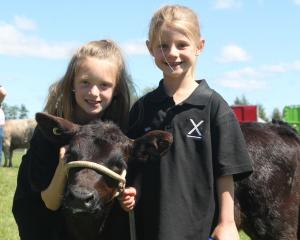

About 120 people attended a Beef + Lamb NZ field day at Awatere Station in Waikaia, about 50km north of Gore, last week.
At the field day, station owners James and Denise Anderson showcased their all-grass wintering system on their nearly 3000ha sheep and cattle breeding and finishing operation.
Mrs Anderson said they "adopted" an all-grass wintering system after moving from a small farm in North Canterbury to buy half of Awatere Station, its west end, in 1993.
After buying the property, a devaluation of the New Zealand dollar gave them the opportunity to cultivate some steep areas covered in gorse and subdivide and put fertiliser on lower hill country .
The altitude of the farm ranged between 300m and 800m.
A "big period" for the farm was between 1999 and 2015, which included buying the other half of the station.
"We were maxed out on the mortgage so things had to work — it was a calculated risk."
The investment included building cattle yards, a shed, staff accommodation and their own house.
During this period of investment, they introduced winter cropping for their hoggets and calves.
In 2016, they reached a "turning point" when they saw their calves in a winter crop of turnips.
"The calves were not happy and the turnips were rolling down to the creek and we thought ‘this is ridiculous’."
The wintering system — losing sediment, crop and presenting a potential animal welfare issue — had become a hot topic.
"Things had changed."
An all-grass wintering system had been used on the station for the past six years.
Last year, they wintered nearly 20,000 stock units on nearly 2500ha.
Mr Anderson said their all-grass wintering system should not be confused with any other type of farming.

They had a focus on sustainability.
Sustainability goals included lowering labour costs and reducing soil loss by methods including direct drilling instead of cultivating when summer regrassing to fatten lambs and steers.
Another sustainability goal was improving output by applying nitrogen in autumn and a little bit in spring.
"The autumn nitrogen has a big impact on what we do here."
Their system had "slowly evolved".
"We came here with a motorbike, one tractor and a topper. For the first five years, we did no cultivating and put all our money into fertiliser and it was the best five years of farming I’ve ever had because nothing broke down."
He would rather invest in fertiliser than tractors.
"We are not grass farmers, we are soil farmers."
Fertiliser had increased production on the farm.
If politicians banned fertiliser, New Zealand was doomed.
"New Zealand is not a fertile country in comparison to the rest of the world — there is far better soils elsewhere."
Other reasons for all-grass wintering was to reduce the environmental impact, increase animal welfare and lift their financial return.
"We are under mortgage pressure."

The goal of the station was to run a low-cost, simple and profitable farming system.
Their all-grass wintering system featured about 35ha of ryecorn.
"Ryecorn is pretty hardy stuff."
The ryecorn paddock was block fed or strip grazed and then used to lamb on.

"We use ryecorn because it fits into pasture renewal."
The station had a "huge" thistle problem and he did not like spraying the weed.
"What’s the point of putting in clover and then spraying it out for thistles — hence we do a lot of topping."
The wintering of their sheep — two mobs of about 1300 hoggets and one mob of more than 2500 two-tooths — was to break-feed them and shift them every day.
"I know it’s a bit of work.
"In a perfect world you’d leave about 1300kg of dry matter behind on hard ground."
Feed budgeting in winter was everything, he said.
"I’m a stickler for sticking to the plan — regardless."

"If you fail to plan, you plan to fail."
Questions from the audience included South Otago sheep and beef farmer Hamish Bielski asking why they now had 3000 lambs on the farm when they had a feed pinch period in spring.
"Aren’t they eating pretty vital feed now that you could take through winter to take pressure off in spring?" Mr Bielski said.
Mr Anderson said the feed value of autumn-saved pasture was non-existent in September.
"So you might as well eat it."
If grass was more than 15cm tall and hit by a frost, its feed value dropped dramatically.
Consequently, their system was reliant on spring growth.
Another audience member asked what was their "get out of jail card" if there was a dry autumn.
In the past 30 years, they had three or four dry autumns on the station.
"Coming from Canterbury, what you classify as dry in Southland is laughable."
The autumn conditions had never got so dry it posed a problem, possibly because of their low stocking rate, off 7.7 stock units per effective ha.
They had spent nearly $2 million on gorse and broom control in the past 20 years.
If they had spent that money covering 75% of the farm in forestry they would be "sitting like fat cats on carbon credits".

"We are not foresters — we are sheep and beef farmers."
Land use
Awatere Station land use
Area: 2964h.
Winter feed: 35ha ryecorn and short rotation rye grass.
Young grass: 106ha — a mix diploid ryegrass, red and white clover, tetraploid ryegrass and pasja.
Pasture: 1123ha
Hill over-sown: 1164ha
Trees and native bush: 405ha
Hill unfertilised: 131ha
Lamb kill
Awatere Station lamb kill statistics 2022-23.
Ewes to the ram: 9900
Scanning percentages: 170% for mixed age ewes and 155% for two-tooths.
Lambing %: 136
Weight: 18.06kg to date
Stock wintered
Awatere Station stock wintered last year
Effective area: 2468ha
Ewes: 9900
Ewe hoggets: 2700
Rams: 152
Ram hoggets 40
Cows and in-calf heifers: 500
Yearling heifers: 230
Yearling steers: 180
Bulls: 26













